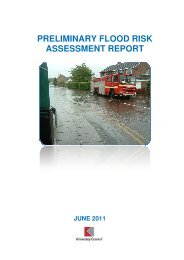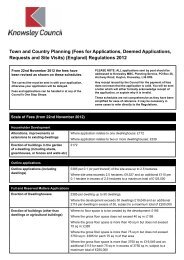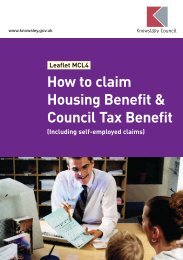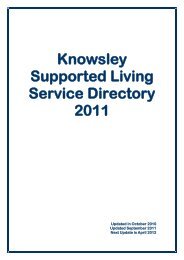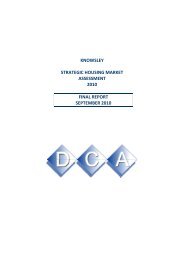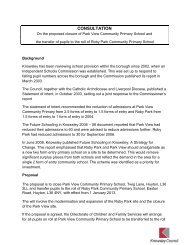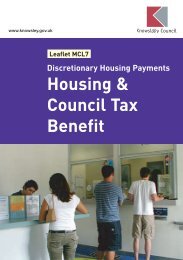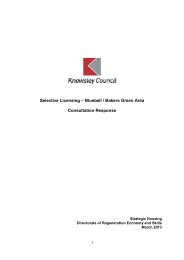Knowsley Replacement Unitary Development Plan - Knowsley Council
Knowsley Replacement Unitary Development Plan - Knowsley Council
Knowsley Replacement Unitary Development Plan - Knowsley Council
You also want an ePaper? Increase the reach of your titles
YUMPU automatically turns print PDFs into web optimized ePapers that Google loves.
COMMUNITY BENEFITS AND PLANNING AGREEMENTS<br />
COMMUNITY BENEFITS AND PLANNING AGREEMENTS<br />
EXPLANATION PA1<br />
14.6<br />
Table 14.1<br />
14.3<br />
In considering any planning applications for<br />
development, the <strong>Council</strong> must assess whether the<br />
development complies with the policies of this <strong>Plan</strong>.<br />
If the development does comply with the policies of<br />
this <strong>Plan</strong>, planning permission will in most cases be<br />
granted. If the development would not comply with<br />
the policies, the <strong>Council</strong> will firstly consider whether<br />
any harm likely to be caused can be alleviated<br />
through the use of planning conditions (see glossary).<br />
Guidance on the use of planning conditions is set<br />
down in DETR Circular 11/95 “The use of conditions<br />
in planning permissions”. If any harm associated with<br />
a development cannot be mitigated by the use of a<br />
condition, the <strong>Council</strong> will then consider whether a<br />
planning agreement can be used to offset the harm<br />
(as an alternative to refusing permission).<br />
14.4<br />
<strong>Plan</strong>ning agreements can either:<br />
• Restrict development or the use of land;<br />
• Require operations to be carried out, or the land<br />
to be used in any specific way; or<br />
• Require payments to be made to the authority<br />
either by a single sum or periodically.<br />
14.5<br />
Agreements can be positive, requiring a developer to<br />
do a specific thing, or negative - restricting a party to<br />
the agreement or his successors from developing or<br />
using the land in a specified way. Agreements must<br />
be directly related to the development and to the UDP<br />
policies and proposals for the area. Agreements may<br />
require provision of a specific community benefit or<br />
facility, and/or a financial contribution towards the<br />
provision of such a benefit by the <strong>Council</strong>.<br />
Developers will only be liable to enter into planning<br />
agreements where their development would not<br />
otherwise (with the use of any conditions which may<br />
be necessary) comply with the policies of this <strong>Plan</strong>.<br />
In practical terms, agreements are unlikely to be<br />
necessary for most minor developments such as<br />
extensions or alteration to existing buildings.<br />
14.7<br />
The content of agreements (for example the size of<br />
any financial contributions that are required) will be<br />
the subject of negotiation between the <strong>Council</strong> and<br />
the prospective developer. The scale and kind of<br />
benefit sought will always be related reasonably to<br />
the needs likely to be generated by the development.<br />
14.8<br />
In the case of planning agreements requiring a<br />
financial contribution towards a community benefit,<br />
payment will be made into specific funds managed by<br />
the <strong>Council</strong> for achieving the requirements of the<br />
policies of the UDP.<br />
POLICY LINKS<br />
The list in table 14.1, which is not exhaustive,<br />
indicates what types of obligation the <strong>Council</strong> is<br />
most commonly likely to seek from developers.<br />
Measures or funding provision likely to be sought<br />
through planning agreements with developers<br />
Chapter Area<br />
Chapter 5<br />
“Housing”<br />
Chapter 6<br />
“Economic<br />
<strong>Development</strong>”<br />
Chapter 7<br />
“Town Centres<br />
and Shopping”<br />
Chapter 8<br />
“Transport”<br />
Measures or funding provision<br />
likely to be sought<br />
• Phasing of large housing sites.<br />
• Use of local labour in new<br />
development proposals.<br />
• Provision of car parking for<br />
use by the public.<br />
• Funding of town centre<br />
improvements such as<br />
improved CCTV provision,<br />
landscaping, paving and street<br />
furniture.<br />
• Improvements to community<br />
buildings such as libraries,<br />
community centres or health<br />
centres.<br />
• Management and promotion of<br />
town centres.<br />
• Improvements to public<br />
transport system<br />
infrastructure, highways,<br />
cycleways and/or pedestrian<br />
routes - see policies<br />
T2, T5, T6, T7 and T9.<br />
Chapter 9 • Off-site landscape<br />
“Green Belt enhancements – see policy G2.<br />
and the Rural<br />
Economy”<br />
Chapter 10 • Provision and maintenance of<br />
“Urban<br />
areas of greenspace or<br />
Greenspace, landscaping principally of<br />
Sport and benefit to the development -<br />
Recreation” see policy OS5.<br />
• Improvements to and provision<br />
of community buildings and<br />
greenspaces for recreational,<br />
leisure, sporting or educational<br />
purposes - see policy OS6.<br />
Chapter Area<br />
Chapter 11<br />
“<strong>Development</strong><br />
Quality and the<br />
Built<br />
Environment”<br />
Measures or funding provision<br />
likely to be sought<br />
• To secure community use of<br />
sporting or educational<br />
facilities.<br />
• Provision of an acceptable<br />
balance and phasing of uses in<br />
mixed-use developments.<br />
• Provision of art or sculpture in<br />
public places.<br />
• Funding of off site<br />
compensatory tree planting -<br />
see policy DQ4.<br />
• Conservation of buildings,<br />
structures and places of<br />
historic or architectural or<br />
archaeological interest - see<br />
policies DQ5 to DQ9.<br />
Chapter 12 • Provision of recycling facilities.<br />
“Minerals, Waste<br />
and Energy”<br />
Chapter 13<br />
“Environmental<br />
Protection and<br />
Nature<br />
Conservation”<br />
• Off site mitigation measures<br />
needed to prevent harm from<br />
pollution or other<br />
environmental risks<br />
(e.g. noise control bunds,<br />
flood prevention measures) -<br />
see policies ENV1 to ENV7.<br />
• Provision of mitigation<br />
measures where a<br />
development would damage a<br />
natural habitat, geological site,<br />
or important species - see<br />
policies ENV9 and 10.<br />
168<br />
KNOWSLEY REPLACEMENT UNITARY DEVELOPMENT PLAN: Adopted June 2006<br />
KNOWSLEY REPLACEMENT UNITARY DEVELOPMENT PLAN: Adopted June 2006<br />
169



